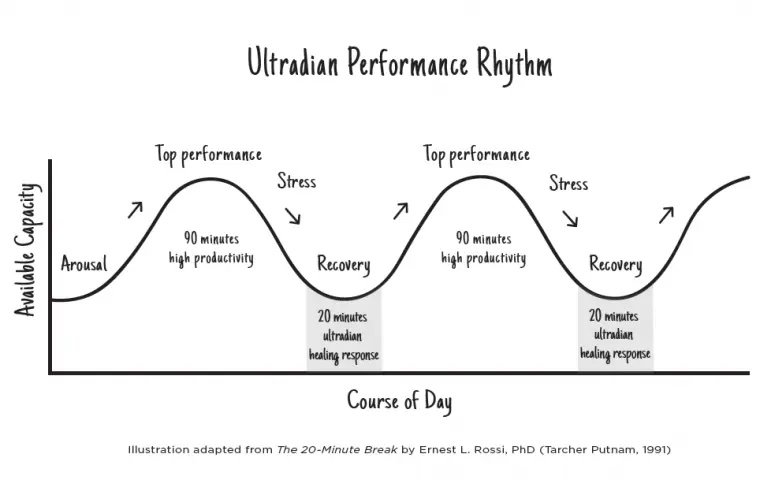Ultradian Healing Response: Stress Less // Achieve More
/Here, you will learn to work alongside your body’s natural rhythms to boost energy, productivity, and motivation.
Insert: Ultradian Rhythm
Ultradian Rhythms are patterns of biological rhythms that have a duration of fewer than 24 hours (circadian rhythms) and are characterized by repeated oscillations or fluctuations in various bodily functions.
3 Examples of Ultradian Rhythms:
Sleep: Consists of multiple cycles, each lasting around 90-120 minutes, and is characterized by different stages of sleep that produce different rest for your bodies and minds: REM, DEEP, and light
Hormones: Cortisol, insulin, and growth hormone can all fluctuate with peaks and valleys during the day.
Brain Wave activity: We all move through various brain waves during the day, alpha, beta, theta, and delta waves, which all correlate with multiple states of consciousness (relaxation, deep concentration, alertness )
Understanding and respecting these cycles positively affects how we can improve our well-being and performance.
One of the most impactful ways to implement these cycles is the Ultradian HEALING Response, as outlined by Psychologist Ernest Rossi in his book, Twenty Minute Break)
The basic principle is that you can only sustain high focus and productivity for roughly 90 minutes. After the 90 minutes, you have essentially depleted your focus ability and need to recharge your batteries for 20 minutes.
After the 20-minute recharge, you can enter another 90-minute focused work sprint.
I like focusing on a 90-minute work section and a 30 min break. This gives me a 5-minute buffer before and after my break for water, bathroom, etc.
Ideally, you continue this format for your entire work day. (example of this at the bottom)
What to do during the 20 or 30-minute break:
TURN YOUR BRAIN OFF!
You can do anything that requires little to zero stimulus.
Walking outside
Stretching
Napping
Breathwork
Sauna / Cold Therapy
Meditation
What is NOT a break:
Discussing your weekend plans with co-workers
Reading
Checking e-mail or social media (include this at the end of your 90 min work block)
Watching TV, Streaming videos
Listening to a book or podcast
Your brain does not know the difference between reading for pleasure or reading for work, planning your presentation or planning a bbq, watching TV, or watching a presentation at work.
All it knows is that information is coming in and needs to be activated, thus not receiving the break.
During your break, fresh stores of fuel (ATP)- are sent to your cells, which help support the rebalancing of your blood sugar, hormones, and neurotransmitters.
If you skip breaks, you will be accruing physiological stress that leads to the typical afternoon slump and, if continued, feelings of exhaustion, overwhelm, and burnout.
Other things you can expect with skipped breaks are:
Increased blood pressure
Inflammation
Higher cholesterol
Lower immunity
Difficulty with digestion
Slowed metabolism
Moodiness and emotional reactivity
Increased sugar and carb cravings
Decreased communication and relational skills
Decreased motor skills
All of the above leads to more mistakes in the workplace and increases our risk for poor performance.
These mistakes can crush our motivation and devastate our confidence as we feel we’re always one or many steps behind.
If we double down on no breaks, the cycle perpetuates even more and affects our sleep, diet, and overall health.
When you don’t follow your natural biology, it leads to unnatural behavior driven by a hormonal imbalance. This often includes a lack of desire for physical intimacy, motivation, sex drive, and overall inflammation leading to disease and more.
If you overdrive ANY system, eventually, it will break down.
The goal is to build a system into your calendar where you’re safeguarding against breakdown AND allowing for INCREASED productivity.
The common story I hear from clients (after a period of “this is bullshit, I can afford to take breaks” ) is that they are getting higher quality work done in 6 hours a day than eight or ten before.
Additionally, they wake up feeling motivated to start their day because they are clear on their work and rest ratio. It helps make the days feel less daunting and more exciting.
This helps lower their overall stress level, which dramatically affects how they feel about themselves, their work, family, and friends.
Start adding breaks into your day next week, and let me know how it works for you.
Here is a simple framework for how to get started:
8 - 9:30 // High Productive Work
9:30 - 10 // Breathwork (eye mask, headphones, no distracted zone) I like the XPT APP
10 - 11:30 // HPW
11:30 - 12:30 // Lunch followed by a walk outside (no phone)
12:30 - 2 // HPW
2 - 2:30 // Nap/Meditation
2:30 - 4 // HPW
Making any change is hard, not only for you but for others around you who now need to adjust to your new schedule.
If you want specialized 1:1 support for building out your schedule with your unique circumstances and support sticking to it, please don’t hesitate to reach out for 1:1 coaching.
I would love to support you.
With heart,
Mike


